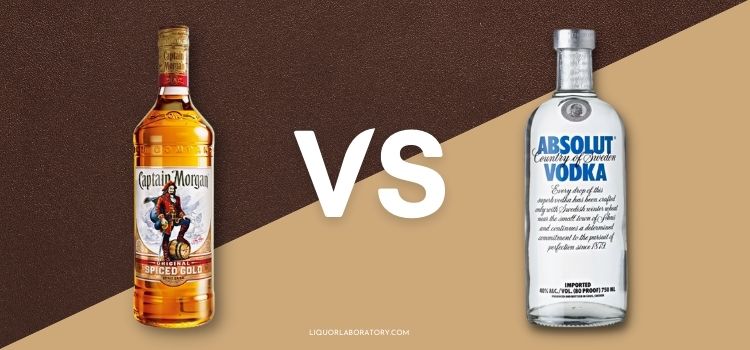Last Updated on March 11, 2024 by Lydia Martin
Popular alcoholic beverages such as rum and vodka are great drinks but have different flavors. Vodka’s lack of flavor may not be pleasant for a new drinker, and the sweetness of rum can be overwhelming.
Let us learn more about rum vs vodka’s differences in taste, color, production process, and price points.
Table of Contents
ToggleVodka & Rum Compared

Rum and vodka are both distilled spirits, but are different in some ways. Vodka comes from the Slavic word, “Voda,” meaning water. Vodka is made from potatoes and grains mixed with alcohol or ethanol. Before it can be considered vodka, it needs to have at least 37.5% alcohol content.
On the other hand, rum is from fermented sugar cane and molasses. The Caribbean Islands produce the best varieties of these drinks. The sweet savor is because of the primary ingredient, molasses. Original vodka lacks this element, but some varieties contain herbs to enhance its flavor.
A Closer Look At Their Differences

Origin
Rum production is said to originate from Barbados in the mid-1600s. It was called “kill-devil or Rumbullion.” However, in 1667, it was finally called rum. It was said that this alcoholic beverage got its name from the Dutch word “Roemer,” which means “large glass.”
Vodka has existed since the 8th or 9th century, but it is unsure whether it began in Russia or Poland. This alcoholic beverage was already available in Russia in the 14th century, according to stories.
Main Ingredients

The main ingredient of rum is sugarcane. Everything about rums derives from sugarcane juice, molasses [1], white or brown sugar, and other by-products. It contributes greatly to the aroma and taste of rum.
On the other hand, vodka is made from potatoes. The lack of extraordinary taste in this product is because of its main ingredient. However, most makers of these spirits choose to add flavorings. There are also vodka varieties that use cereals and grains, similar to brandy.
Preparation Process
Unlike other drinks, bar rum begins with the extraction of sugarcane juice. The juice is then cooked and turned into molasses. Molasses is then added with yeast and water to start fermentation.
Distillation follows inside stainless steel tanks where fermented rum is stored. It will be heated and condensed before it will continue to the aging process. After a specified aging period, blending follows for a flavored rum.
Vodka is processed almost the same. Potatoes, grains, and beets are the common source of vodka. It goes through fermentation and then distillation afterward. These are also stored in stainless steel tanks, but it does not require aging.
Color

The color of a rum depends on its flavor profile. Those that pass through the aging process acquire a darker brown color. The influence of the wooden oak barrels will show in every bottle. However, you will also find white rums filtered to remove impurities and achieve that specific color.
Original vodka only has one color, and that is clear as water. It normally is double distilled to reach a clear state. But to strengthen the alcohol flavor, manufacturers distill it some more until they get that good savor. Also, some vodkas bear the color of their special flavor.
Use
Rum is made of sugarcane that is why it has a better flavor. However, it is enjoyed as an alcoholic drink and as an ingredient for cooking. Good light rum is perfect for dishes with poultry and seafood contents. Darker rums fit for proteins such as beef stew.
On the other hand, vodka is also a common ingredient in complex dishes. Since it does not have a strong flavor, you won’t worry about it overpowering the natural savor unless you pour a lot. Also, it can act as an emulsifier that can enhance the dishes’ taste and consistency.
Taste & Flavor Notes

Between rum vs vodka, taste and flavor automatically go to rum. Since molasses is its source, it has a natural sweetness. This type of liquor is popular with new drinkers as these are easier to swallow than other mixed drinks. There are also flavored types, orange, mango, banana, and lime.
Vodka is rarely aged. It makes its savor strong and very straightforward. However, there are herbs and fruit-infused vodka. It gives the once tasteless drink notes of fruits and tang of herbage. Blood orange, cranberry, cucumber, grapefruit, and ginger zest are just a few flavors infused in vodka.
Read: Bacardi Gold & Superior Rum Comparison
Alcohol By Volume Level
Rum holds a minimum of 35.5% alcohol level, which goes up to 80%, depending on the number of distilled times. A typical rum distillation is once, but darker spirits go through the pot stills twice to increase its alcohol content. Afterward, it needs to be aged to refine and develop a more sophisticated taste.
Vodka goes through a different phase. Some are from grains, while others are from potatoes. However, they go through distillation more than once. Alcohol content can be 80 proof but can go as high as 95 vodka proof. Popular brands often distill their vodkas to raise their alcohol content.
Difficulty in Making Cocktails

Rum is not a difficult spirit to mix in cocktails. It is also the same with vodka. These two are the most popular ones when it comes to mixed drinks.
However, vodka is preferred more if you make cocktails that require a stronger kick. This fermented spirit can provide that necessary strength in a drink, plus it is clear and almost flavorless.
A typical rum has color, but this spirit also has varieties filtered with carbon that ends up clear and white. White rum is usually paired with soda, the same way you use gin.
Price & Value
Another main difference between rum vs vodka is their price and value. Rum’s production is not as complicated as others, but an alcoholic drink kept in oak casks costs is higher. A budget rum is roughly $11 to $18. A standard bottle of rum ranges from $20 to $29. The premium bottle of rum costs around $30 to $38 in a bar or liquor store.
Vodka, on the other hand, requires fewer processes after fermentation. Also, its ingredients are fairly easy to use and do not require aging at the same time. A bottle of budget vodka ranges from $7 to $19. Standard vodka is roughly $20 to $27, while premium vodka is around $29 to $740.
Calorific Content

Considering that the ingredients of these drinks are sugarcane, wheat, grains, and potatoes, we are still bound to see calories in them. However, the two have one of the lowest-calorie content at 231 calories in every 100 grams.
Beer and tequila have lower calories than these two, at 43 and 69, respectively. You can drink any liquor daily, as long as it is minimal.
FAQs
Is rum a healthier alcohol?
While no alcoholic beverage can be considered “healthy” per se, some argue that rum may have certain potential health benefits compared to other spirits. Rum is often associated with a lower likelihood of causing hangovers due to its relatively lower congeners content, which are compounds formed during fermentation and contribute to hangover symptoms. Additionally, rum is thought to contain antioxidants, such as polyphenols, derived from the sugarcane or molasses used in its production.
However, it’s crucial to approach such claims with caution. Excessive alcohol consumption, regardless of the type of beverage, can lead to various health issues, including liver damage, cardiovascular problems, and an increased risk of addiction. The overall impact on health depends on factors such as individual tolerance, frequency of consumption, and accompanying lifestyle choices.
In conclusion, while some argue that rum may have certain minor advantages over other spirits, moderation remains the key to minimizing health risks associated with alcohol consumption. It is always advisable to consult with healthcare professionals for personalized advice regarding alcohol and its potential effects on one’s health.
Why is rum the best alcohol?
The notion of any particular alcohol being the “best” is subjective and depends on personal preferences. However, rum has distinct qualities that contribute to its popularity and appeal. First and foremost is its rich and diverse flavor profile, ranging from sweet and fruity to bold and spicy, depending on the type and aging process. This versatility makes rum suitable for various cocktails and sipping occasions.
Rum’s production process, often involving sugarcane or molasses, contributes unique characteristics and complexities to the final product. The aging process in barrels further enhances its flavor, imparting notes of caramel, vanilla, and oak.
Moreover, the cultural and historical significance of rum, intertwined with tales of pirates and exotic locales, adds to its allure. Rum has a global presence, with different regions producing distinct varieties such as Caribbean, Latin American, and even spiced or flavored versions.
While personal preferences vary, the diversity in flavors, cultural connections, and the adaptability of rum in mixology contribute to its status as a beloved and versatile spirit. Ultimately, the “best” alcohol is subjective, but rum’s widespread popularity attests to its enduring appeal in the world of spirits.
Can I use rum instead of vodka?
Declaring any alcohol as the absolute best is subjective, as preferences vary widely. However, rum boasts several characteristics that contribute to its appeal and popularity. One key factor is its diverse flavor spectrum, ranging from sweet and tropical to robust and spiced, providing a broad palate for consumers. The production process, often involving sugarcane or molasses, imparts unique and complex flavors, further enriched by aging in barrels.
Rum’s versatility is another significant factor. It serves as a base for an array of cocktails, from classic mojitos to exotic tiki drinks, showcasing its adaptability in mixology. The spirit’s cultural and historical associations, linked to maritime traditions, piracy, and colonial history, contribute to its mystique and allure.
Furthermore, the global reach of rum, with distinct varieties emerging from different regions like the Caribbean, Latin America, and beyond, highlights its widespread popularity. Whether sipped neat or incorporated into diverse concoctions, rum’s broad appeal and rich history make it a favorite among enthusiasts. Nevertheless, individual tastes play a crucial role, and the title of the “best” alcohol remains a matter of personal preference.
Does rum and vodka have different effects?
Yes, rum and vodka can have different effects on individuals due to variations in their alcohol content and additional compounds. Vodka typically has a higher alcohol by volume (ABV) percentage than rum, often around 40%, while rum can range from 35% to 50% ABV. This difference can influence the rate of alcohol absorption and metabolism, affecting the onset and intensity of intoxication.
Moreover, the production process and ingredients contribute to distinct flavor profiles and the presence of congeners, byproducts of fermentation. Congeners can influence the characteristics of a hangover and contribute to the overall effects of alcohol. While vodka is often associated with a cleaner, neutral taste, rum’s flavor complexity can result in a different drinking experience.
Ultimately, variations in alcohol content, congeners, and flavor contribute to potential differences in how individuals experience the effects of rum and vodka. Personal tolerance, drinking context, and overall health also play significant roles in determining the impact of these alcoholic beverages.
Why is rum better than vodka?
Declaring one spirit as “better” than another is subjective and depends on personal preferences. However, some enthusiasts argue that rum offers unique qualities that make it preferable to vodka for certain occasions. Rum’s diverse flavor spectrum, ranging from sweet and tropical to bold and spiced, provides a broader palate for consumers compared to vodka’s relatively neutral taste.
The production process, often involving sugarcane or molasses, imparts distinctive and complex flavors to rum, which can be further enriched by aging in barrels. This complexity contributes to rum’s versatility as a base for various cocktails, from classic mojitos to exotic tiki drinks, showcasing its adaptability in mixology.
Additionally, rum’s cultural and historical associations, linked to maritime traditions, piracy, and colonial history, contribute to its mystique and allure. The global reach of rum, with distinct varieties emerging from regions like the Caribbean and Latin America, highlights its widespread popularity.
While some may argue that rum’s flavor diversity, cultural connections, and adaptability make it preferable to vodka, taste remains highly subjective. Preferences vary widely, and choosing between rum and vodka ultimately depends on individual taste and the desired drinking experience.
What is the unhealthiest alcohol?
Determining the “unhealthiest” alcohol can be complex as various factors contribute to the overall impact on health. Sugary, flavored, and heavily processed alcoholic beverages are often considered less healthy due to their high calorie and sugar content. Cocktails with added syrups and mixers can contribute to excessive calorie intake, leading to weight gain and potential negative effects on overall health.
Furthermore, excessive alcohol consumption itself poses health risks, including liver damage, cardiovascular issues, and an increased risk of addiction. Binge drinking and the consumption of high-proof spirits can exacerbate these risks. Ultimately, moderation and mindful drinking are crucial for minimizing potential health consequences associated with alcohol consumption.
Which is stronger: Vodka or Rum?
The strength of vodka and rum is measured by their alcohol by volume (ABV) percentage. Generally, both vodka and rum can vary in strength, but vodka is often known for its higher alcohol content. Vodka typically has an ABV ranging from 35% to 50%, while rum’s ABV can fall between 35% and 50% as well, depending on the specific type and brand.
In essence, the strength of vodka and rum can be comparable, and it ultimately depends on the specific product. Some vodkas may have a higher ABV than certain rums and vice versa. When choosing between the two, it’s essential to check the alcohol content indicated on the label to determine their relative strength. It’s worth noting that the perceived strength of a drink can also be influenced by factors such as flavor, mixers, and personal tolerance.Is rum good for the Liver?
Which is cheaper: Rum or Vodka?
The relative affordability of rum and vodka depends on various factors, including brand, quality, and region. Generally, however, vodka is often considered more cost-effective than rum. Vodka’s production process, typically involving distillation and filtration to achieve a neutral flavor, may contribute to lower production costs. Additionally, the simplicity of ingredients, often distilled from grains or potatoes, can make vodka more economically produced.
Rum, on the other hand, can vary widely in price, with factors such as the aging process, brand, and production methods influencing the cost. Aged and premium rums tend to be more expensive due to the time and craftsmanship involved in their production.
While individual preferences and regional variations may impact pricing, in many cases, vodka is perceived as a more budget-friendly option compared to rum.
Which alcohol gives less hangover?
The likelihood and severity of a hangover are influenced by various factors, including alcohol content, congeners, hydration, and individual differences in metabolism. In general, beverages with lower congener content, such as clear spirits like vodka, are often associated with milder hangovers.
Vodka, known for its relatively neutral flavor and minimal congeners, might be considered less likely to cause a severe hangover compared to darker spirits like whiskey or red wine. However, individual tolerance, hydration levels, and the quantity consumed also play crucial roles in hangover susceptibility.
Ultimately, moderation and responsible drinking practices, including staying hydrated and eating before drinking, can help minimize the risk of hangovers, regardless of the type of alcohol consumed. It’s essential to recognize that there is no guaranteed hangover-free alcohol, and personal experiences can vary.
Rum vs Vodka Summary
In summary, rum comes from sugarcane juice and molasses, while vodka is from wheat and potatoes. Rum has a sweet taste and aroma, while vodka will only be a flavored wine once you infuse fruit or other additives.
Mixed drinks like Martinis are perfect with vodka. But the sweetness of gold rum, dark rum, and light rums makes tropical drinks and cocktails more flavorful. Others prefer the sweet-spiky taste of rum vodka. Therefore, regardless of the difference between the two, it all ends with the drinker’s taste buds.
Reference:
















